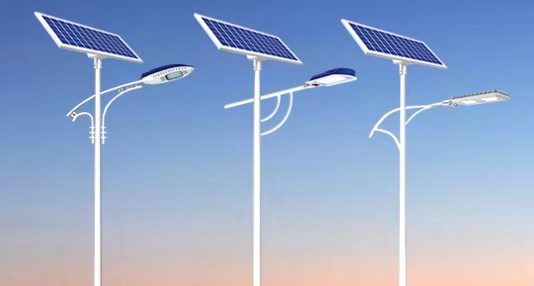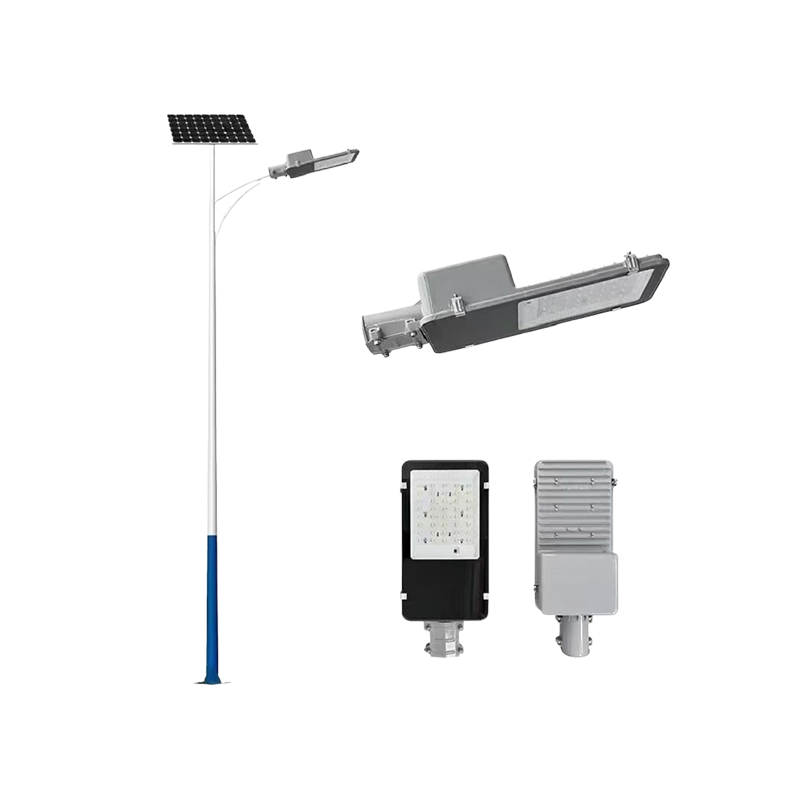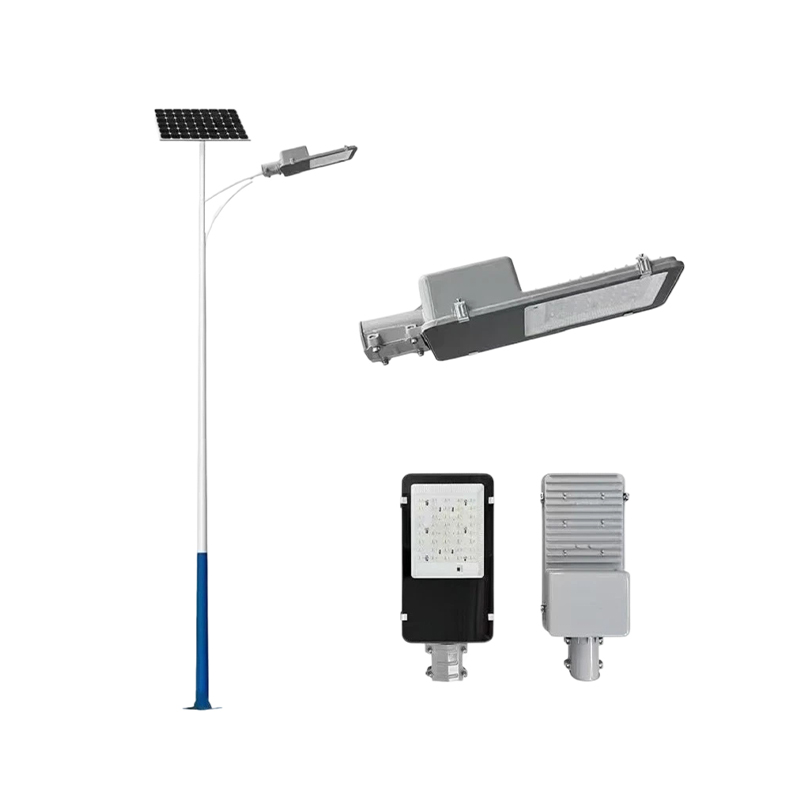Wired Power Supply vs. Off-Grid Lighting: The Independence Advantages of Solar Street Lights
Release Time : 2025-10-30
Against the backdrop of accelerated urbanization and energy transformation, the competition between traditional grid-connected street lights and solar street lights has intensified. Taking a certain model of solar street light as an example (featuring Q235 steel lamp posts, IP65 waterproof LED light heads, lithium iron phosphate batteries, and solar panels with a conversion rate exceeding 18%), this article systematically analyzes the independence advantages of solar street lights from three dimensions: technical principles, economic efficiency, and environmental adaptability.

1. Energy Autonomy: From Grid Dependence to Direct Solar Energy Utilization
Traditional grid-connected street lights require cable connections to the power grid, and their power supply stability is constrained by grid coverage and line losses. Taking a road renovation project in a certain city as an example, laying grid-connected street lights for 1 kilometer necessitates excavating 300 meters of road surface and laying 2 tons of cables, with an initial investment exceeding $50,000. In contrast, solar street lights capture solar energy directly through solar panels, convert it into electrical energy via controllers, and store it in lithium iron phosphate batteries, enabling "plug-and-play" installation. Data from a road project in a remote mountainous area shows that after adopting solar street lights, cable laying costs decreased by 92%, and construction periods were shortened by 60%.
From a technical perspective, the solar panels of this model boast a conversion rate exceeding 18%. Under average daily sunlight conditions of 5 hours, the daily electricity generation can meet the 6-hour full-load operation requirements of the LED light head. The lithium iron phosphate batteries offer a service life of 5-7 years and support over 2,000 charge-discharge cycles. Their energy density is 40% higher than that of lead-acid batteries, and their low-temperature performance (-20°C capacity retention rate ≥85%) significantly outperforms traditional energy storage solutions. This closed-loop energy system renders solar street lights indispensable in areas without grid access and emergency lighting scenarios.

2. Structural Reliability: From Complex Systems to Modular Integration
The structural complexity of grid-connected street lights is evident in multiple aspects, including cable connections, distribution box installations, and grounding protection. Statistics from a coastal city during the typhoon season reveal that failures caused by loose cables and water ingress into distribution boxes account for 12% of annual failures, with maintenance costs constituting 8% of the initial investment. In contrast, solar street lights adopt an integrated design: Q235 steel, after hot-dip galvanizing and coating, exhibits a salt spray corrosion resistance of over 1,000 hours, while the conical tube structure reduces wind resistance by 30%. The LED light heads, crafted through aluminum alloy die-casting, feature an IP65 protection rating, enabling them to withstand solid particles up to 2.5mm in diameter and low-pressure water jets.
Taking the lamp post as an example, the yield strength of Q235 steel is 235MPa, and the conical tube design enhances bending stiffness by 25%. Real-world testing data from a northern city shows that under 8-level wind conditions, the top displacement of solar street light posts is 42% less than that of grid-connected street light posts. The modular design further enhances maintenance convenience—when an LED light source fails, the entire light head module can be replaced without power interruption, reducing repair time from 2 hours for grid-connected street lights to 15 minutes.

3. Economic Analysis: From Long-Term Costs to Full Lifecycle Benefits
In terms of initial investment, a single set of grid-connected street lights costs approximately 3,000(includingcablesanddistributionboxes),whileasinglesetofsolarstreetlightscostsaround 4,500. However, significant differences emerge in full lifecycle costs: over a 10-year usage period, grid-connected street lights incur electricity costs of 24,000perkilometer(assuming
0.8 per kWh and an average daily consumption of 15 kWh), whereas solar street lights have zero electricity costs. Regarding maintenance costs, grid-connected street lights require an average annual replacement of cables, contactors, and other components, costing approximately 800perkilometer,whilesolarstreetlightsonlynecessitatebatterypackreplacement(costingaround1,200 per kilometer) in the fifth year.
The environmental adaptability advantages further amplify economic benefits. In regions like the Qinghai-Tibet Plateau, where annual sunshine exceeds 3,000 hours, solar street lights save over $30,000 per kilometer in electricity costs compared to grid-connected street lights. In high-salt-fog environments like Hainan Island, the corrosion resistance costs of hot-dip galvanized lamp posts are 75% lower than those of ordinary steel. An international aid project in sub-Saharan Africa deployed solar street lights, achieving a 5-year failure rate of only 3%, a ninefold improvement over local grid-connected street lights (28% failure rate).
4. Technological Evolution: From Functional Lighting to Intelligent IoT
Currently, solar street lights are transcending their role as mere lighting fixtures and evolving into intelligent IoT platforms. A company has developed an NB-IoT intelligent control system capable of real-time monitoring of solar panel efficiency, battery health, and light intensity, dynamically adjusting lighting strategies through AI algorithms. During a pilot project in a smart park in Zhejiang, this system reduced energy consumption by 35% and achieved a 98% accuracy rate in fault prediction.
Advances in materials science continue to drive performance improvements. Next-generation perovskite solar panels have achieved conversion rates exceeding 22%, an 18% increase over traditional crystalline silicon panels. Graphene heat dissipation coatings have reduced the operating temperature of LED light heads by 15°C, decreasing light degradation from 3% per year to 1.2%. These technological breakthroughs are reshaping the economic boundaries of solar street lights—according to projections, when solar panel conversion rates reach 25%, their levelized cost of electricity will fall below $0.03 per kWh, enabling competitiveness with thermal power.

Independence Reshaping the Lighting Industry Landscape
The independence advantages of solar street lights fundamentally stem from the synergy between the energy revolution and materials science. From the structural support of Q235 steel to the energy storage of lithium iron phosphate batteries, and from the light conversion of LEDs and solar panels, each technological breakthrough reinforces their ability to operate independently of the power grid. Whether illuminating the snowy plateaus along the Sichuan-Tibet Highway or withstanding typhoons on South China Sea islands, this independence transcends technical boundaries, becoming a pivotal force in driving green infrastructure development and achieving carbon neutrality goals. As solid-state batteries, flexible solar films, and other technologies commercialize, the independence boundaries of solar street lights will continue to expand, redefining the possibilities of urban lighting.

1. Energy Autonomy: From Grid Dependence to Direct Solar Energy Utilization
Traditional grid-connected street lights require cable connections to the power grid, and their power supply stability is constrained by grid coverage and line losses. Taking a road renovation project in a certain city as an example, laying grid-connected street lights for 1 kilometer necessitates excavating 300 meters of road surface and laying 2 tons of cables, with an initial investment exceeding $50,000. In contrast, solar street lights capture solar energy directly through solar panels, convert it into electrical energy via controllers, and store it in lithium iron phosphate batteries, enabling "plug-and-play" installation. Data from a road project in a remote mountainous area shows that after adopting solar street lights, cable laying costs decreased by 92%, and construction periods were shortened by 60%.
From a technical perspective, the solar panels of this model boast a conversion rate exceeding 18%. Under average daily sunlight conditions of 5 hours, the daily electricity generation can meet the 6-hour full-load operation requirements of the LED light head. The lithium iron phosphate batteries offer a service life of 5-7 years and support over 2,000 charge-discharge cycles. Their energy density is 40% higher than that of lead-acid batteries, and their low-temperature performance (-20°C capacity retention rate ≥85%) significantly outperforms traditional energy storage solutions. This closed-loop energy system renders solar street lights indispensable in areas without grid access and emergency lighting scenarios.

2. Structural Reliability: From Complex Systems to Modular Integration
The structural complexity of grid-connected street lights is evident in multiple aspects, including cable connections, distribution box installations, and grounding protection. Statistics from a coastal city during the typhoon season reveal that failures caused by loose cables and water ingress into distribution boxes account for 12% of annual failures, with maintenance costs constituting 8% of the initial investment. In contrast, solar street lights adopt an integrated design: Q235 steel, after hot-dip galvanizing and coating, exhibits a salt spray corrosion resistance of over 1,000 hours, while the conical tube structure reduces wind resistance by 30%. The LED light heads, crafted through aluminum alloy die-casting, feature an IP65 protection rating, enabling them to withstand solid particles up to 2.5mm in diameter and low-pressure water jets.
Taking the lamp post as an example, the yield strength of Q235 steel is 235MPa, and the conical tube design enhances bending stiffness by 25%. Real-world testing data from a northern city shows that under 8-level wind conditions, the top displacement of solar street light posts is 42% less than that of grid-connected street light posts. The modular design further enhances maintenance convenience—when an LED light source fails, the entire light head module can be replaced without power interruption, reducing repair time from 2 hours for grid-connected street lights to 15 minutes.

3. Economic Analysis: From Long-Term Costs to Full Lifecycle Benefits
In terms of initial investment, a single set of grid-connected street lights costs approximately 3,000(includingcablesanddistributionboxes),whileasinglesetofsolarstreetlightscostsaround 4,500. However, significant differences emerge in full lifecycle costs: over a 10-year usage period, grid-connected street lights incur electricity costs of 24,000perkilometer(assuming
0.8 per kWh and an average daily consumption of 15 kWh), whereas solar street lights have zero electricity costs. Regarding maintenance costs, grid-connected street lights require an average annual replacement of cables, contactors, and other components, costing approximately 800perkilometer,whilesolarstreetlightsonlynecessitatebatterypackreplacement(costingaround1,200 per kilometer) in the fifth year.
The environmental adaptability advantages further amplify economic benefits. In regions like the Qinghai-Tibet Plateau, where annual sunshine exceeds 3,000 hours, solar street lights save over $30,000 per kilometer in electricity costs compared to grid-connected street lights. In high-salt-fog environments like Hainan Island, the corrosion resistance costs of hot-dip galvanized lamp posts are 75% lower than those of ordinary steel. An international aid project in sub-Saharan Africa deployed solar street lights, achieving a 5-year failure rate of only 3%, a ninefold improvement over local grid-connected street lights (28% failure rate).
4. Technological Evolution: From Functional Lighting to Intelligent IoT
Currently, solar street lights are transcending their role as mere lighting fixtures and evolving into intelligent IoT platforms. A company has developed an NB-IoT intelligent control system capable of real-time monitoring of solar panel efficiency, battery health, and light intensity, dynamically adjusting lighting strategies through AI algorithms. During a pilot project in a smart park in Zhejiang, this system reduced energy consumption by 35% and achieved a 98% accuracy rate in fault prediction.
Advances in materials science continue to drive performance improvements. Next-generation perovskite solar panels have achieved conversion rates exceeding 22%, an 18% increase over traditional crystalline silicon panels. Graphene heat dissipation coatings have reduced the operating temperature of LED light heads by 15°C, decreasing light degradation from 3% per year to 1.2%. These technological breakthroughs are reshaping the economic boundaries of solar street lights—according to projections, when solar panel conversion rates reach 25%, their levelized cost of electricity will fall below $0.03 per kWh, enabling competitiveness with thermal power.

Independence Reshaping the Lighting Industry Landscape
The independence advantages of solar street lights fundamentally stem from the synergy between the energy revolution and materials science. From the structural support of Q235 steel to the energy storage of lithium iron phosphate batteries, and from the light conversion of LEDs and solar panels, each technological breakthrough reinforces their ability to operate independently of the power grid. Whether illuminating the snowy plateaus along the Sichuan-Tibet Highway or withstanding typhoons on South China Sea islands, this independence transcends technical boundaries, becoming a pivotal force in driving green infrastructure development and achieving carbon neutrality goals. As solid-state batteries, flexible solar films, and other technologies commercialize, the independence boundaries of solar street lights will continue to expand, redefining the possibilities of urban lighting.







